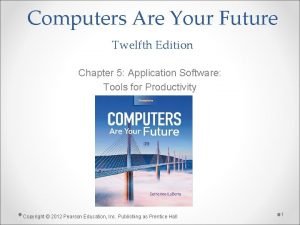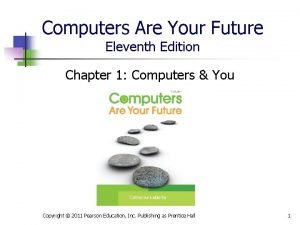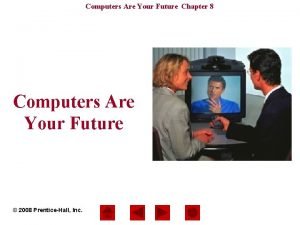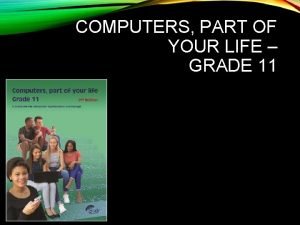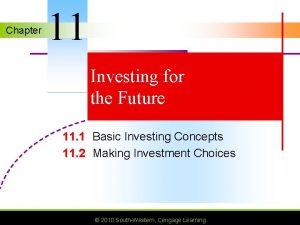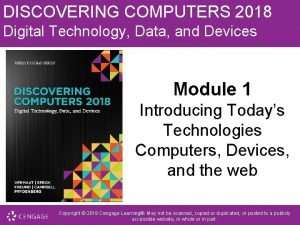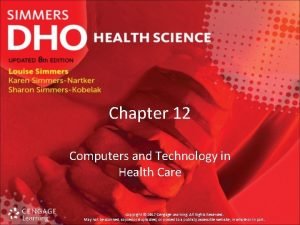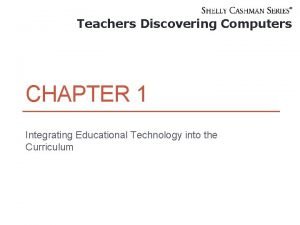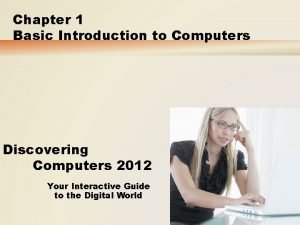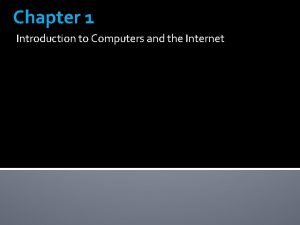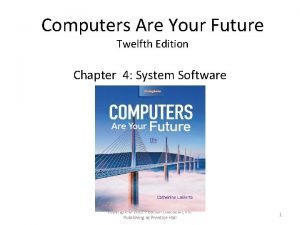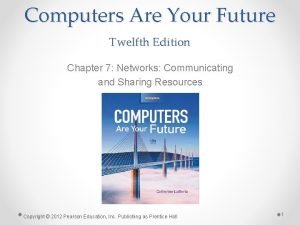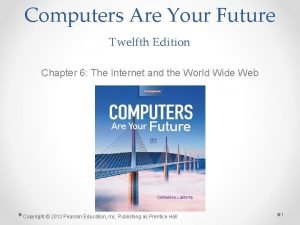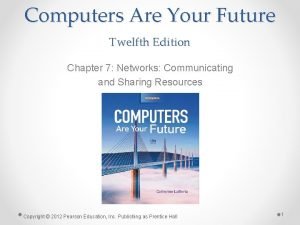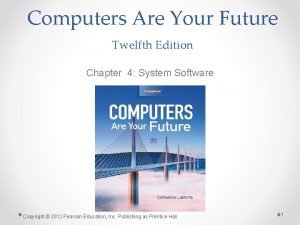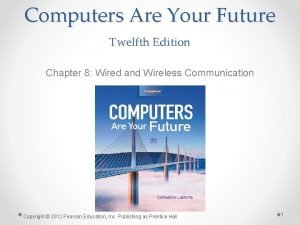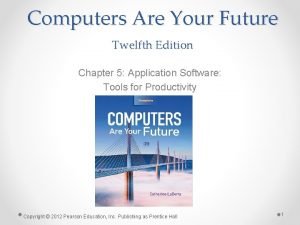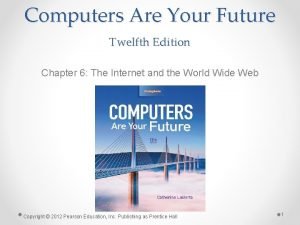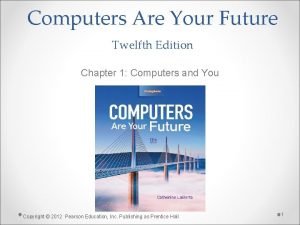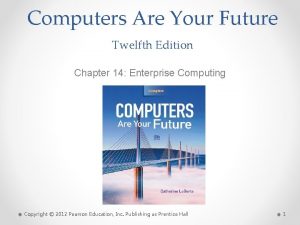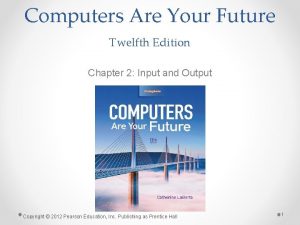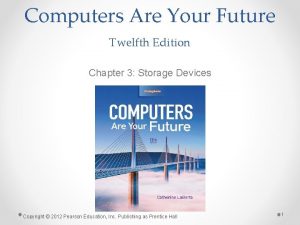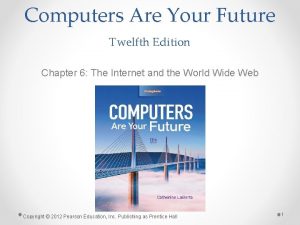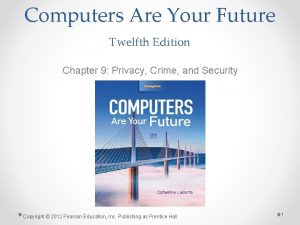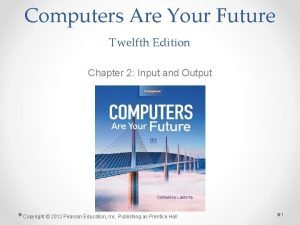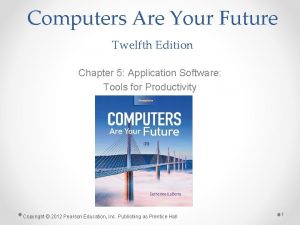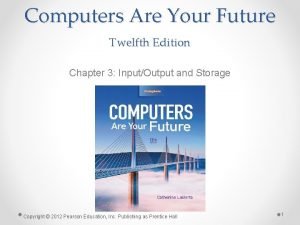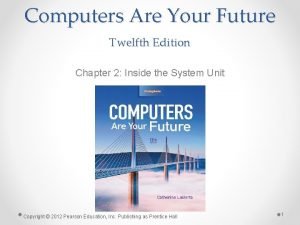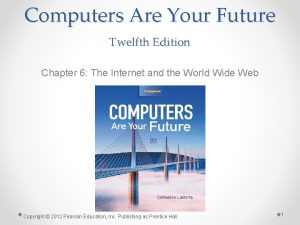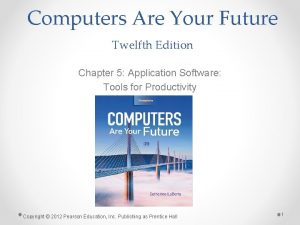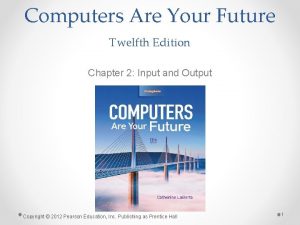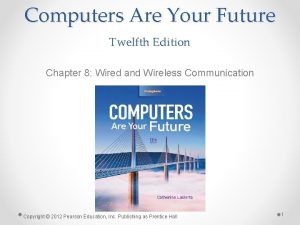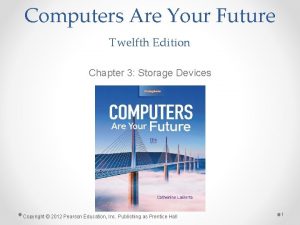Computers Are Your Future Twelfth Edition Chapter 3

























![Storage: Holding Data for Future Use • Flash drive (solid-state drive [SSD]) o Storage Storage: Holding Data for Future Use • Flash drive (solid-state drive [SSD]) o Storage](https://slidetodoc.com/presentation_image/05eab4d9379d0ab758e243d50b6474ea/image-26.jpg)














- Slides: 40

Computers Are Your Future Twelfth Edition Chapter 3: Storage Devices Copyright © 2012 Pearson Education, Inc. Publishing as Prentice Hall 1

Objectives • List and compare the various optical storage media and devices available for personal computers. • Describe solid-state storage devices and compare them with other types of storage devices. Copyright © 2012 Pearson Education, Inc. Publishing as Prentice Hall 2

Storage: Holding Data for Future Use • Storage o Process of saving software and data o Also called mass storage, auxiliary storage, or secondary storage Copyright © 2012 Pearson Education, Inc. Publishing as Prentice Hall 3

Storage: Holding Data for Future Use • Storage devices o Hardware that contains the tools to place data on the recording media o Recording media—hold data • Hard disks • Floppy disks • Flash memory • CDs and DVDs Copyright © 2012 Pearson Education, Inc. Publishing as Prentice Hall 4

Storage: Holding Data for Future Use Copyright © 2012 Pearson Education, Inc. Publishing as Prentice Hall 5

• There are two types of storage devices used with computers: • Primary storage device, such as RAM, ROM, CACHE and a secondary storage device, like a hard drive. Secondary storage can be removable, internal, or external storage. Copyright © 2012 Pearson Education, Inc. Publishing as Prentice Hall 6

Storage: Holding Data for Future Use • Memory (RAM) versus storage o Storage devices retain data even if power is turned off o Data stored in memory (RAM) will be lost o Storage devices are less expensive than memory Copyright © 2012 Pearson Education, Inc. Publishing as Prentice Hall 7

Storage: Holding Data for Future Use • Memory (RAM) o Primary memory o Temporary holding area for items in use o Primary storage • Storage devices o Required during the computer system’s start-up operations o Used as an output device for saving data Copyright © 2012 Pearson Education, Inc. Publishing as Prentice Hall 8

Storage: Holding Data for Future Use • Hard disk drive (hard drive) o Most important storage device o High-capacity, high-speed device o Considered secondary storage (online; fixed storage), compared with memory/RAM, which is categorized as primary storage o Use disks that are coated with magnetically sensitive material (magnetic storage devices) o There are both internal and external hard disks Copyright © 2012 Pearson Education, Inc. Publishing as Prentice Hall 9

Internal hard disk Copyright © 2012 Pearson Education, Inc. Publishing as Prentice Hall 10

External Hard Disk Copyright © 2012 Pearson Education, Inc. Publishing as Prentice Hall 11

Storage: Holding Data for Future Use • Platters—rapidly rotating disks on which programs, data, and processed results are stored • . Copyright © 2012 Pearson Education, Inc. Publishing as Prentice Hall 12

PLATTERS • One or more aluminum, glass, or ceramic disk that is coated in a magnetic media and is located within a hard drive to permanently store all your computers data. When the computer is turned on, these platters will begin to rotate at so many rotations per minute (RPM) Copyright © 2012 Pearson Education, Inc. Publishing as Prentice Hall 13

Storage: Holding Data for Future Use Copyright © 2012 Pearson Education, Inc. Publishing as Prentice Hall 14

Copyright © 2012 Pearson Education, Inc. Publishing as Prentice Hall 15

Copyright © 2012 Pearson Education, Inc. Publishing as Prentice Hall 16

TRACKS • Tracks—concentric bands on which data is recorded. • Track is a physical division of data in a disk drive, as used in the Cylinder-Heado Are divided into sectors o Two or more sectors is a cluster Copyright © 2012 Pearson Education, Inc. Publishing as Prentice Hall 17

Copyright © 2012 Pearson Education, Inc. Publishing as Prentice Hall 18

Copyright © 2012 Pearson Education, Inc. Publishing as Prentice Hall 19

Storage: Holding Data for Future Use • To keep track of where specific files are located, the computer’s operating system records a table of information (file’s name and its location) on the disk • This is known as New Technology File System (NTFS). The present system used for tracking file locations in: Windows NT, Windows 2000, Windows XP, Windows Vista, Windows 7 • E. g. File Name Track Sector Letter. doc 4 3 Sales. xls 14 8 Copyright © 2012 Pearson Education, Inc. Publishing as Prentice Hall 20

Storage: Holding Data for Future Use • Partitions o Act of dividing a hard disk into multiple sections (storage units) o Portion of a hard disk set aside as if it were a physically separate disk o Often used to house different operating systems o Allows users to use programs developed for different systems Copyright © 2012 Pearson Education, Inc. Publishing as Prentice Hall 21

Storage: Holding Data for Future Use • Hard disk performance o Affected by bad sectors—damaged portions of the disk that cannot reliably hold data o Positioning performance—how quickly the read/write head can get into position to transfer data o Transfer performance—how quickly the transfer is made from the disk to storage Copyright © 2012 Pearson Education, Inc. Publishing as Prentice Hall 22

Storage: Holding Data for Future Use • Hard disk performance (con’t. ) o Disk cache—type of cache memory • CPU looks here first before the hard disk • Using the disk cache speeds up data retrieval Copyright © 2012 Pearson Education, Inc. Publishing as Prentice Hall 23

Storage: Holding Data for Future Use • Network attached storage (NAS) o Permits retrieval or storage of data by any computer connected to the network • Remote storage (Internet hard drive) o Storage on a server that is available through the Internet Copyright © 2012 Pearson Education, Inc. Publishing as Prentice Hall 24

Storage: Holding Data for Future Use Cloud Storage Service Companies Copyright © 2012 Pearson Education, Inc. Publishing as Prentice Hall 25
![Storage Holding Data for Future Use Flash drive solidstate drive SSD o Storage Storage: Holding Data for Future Use • Flash drive (solid-state drive [SSD]) o Storage](https://slidetodoc.com/presentation_image/05eab4d9379d0ab758e243d50b6474ea/image-26.jpg)
Storage: Holding Data for Future Use • Flash drive (solid-state drive [SSD]) o Storage devices that use solid-state circuitry; have no moving parts o Increasing in use • Flash memory o Nonvolatile electronic memory stored in blocks on a chip o Limited to 100, 000 write cycles Copyright © 2012 Pearson Education, Inc. Publishing as Prentice Hall 26

Storage: Holding Data for Future Use • Hybrid hard drives (HHDs) o Incorporate flash technology to speed up the boot process • USB flash drives (memory stick, thumb drive, jump drive) o o Popular portable or removable storage devices Replace legacy technology of floppy disks and Zip disks Do not require a device driver Should be removed only when not actively in use Copyright © 2012 Pearson Education, Inc. Publishing as Prentice Hall 27

Storage: Holding Data for Future Use • CD drives and DVD drives o Optical storage devices o Use laser beams to store data through: • Pits, the indentations, a binary 0 • Lands, the flat reflective areas, a binary 1 • Optical discs o CD-ROM or DVD-ROM (compact or digital video disc read-only memory) o Data can be read, not altered o Most popular, least expensive Copyright © 2012 Pearson Education, Inc. Publishing as Prentice Hall 28

Storage: Holding Data for Future Use Optical Disc Formats Optical Disc Types Copyright © 2012 Pearson Education, Inc. Publishing as Prentice Hall 29

Storage: Holding Data for Future Use Additional types of optical storage o CD-R (CD-recordable) o CD-RW (CD-rewritable) o DVD+R (DVD recordable; plus) o DVD-R (DVD recordable; dash) Copyright © 2012 Pearson Education, Inc. Publishing as Prentice Hall o DVD+RW (DVD rewritable; plus) o DVD-RW (DVD rewritable; dash) o BD-ROM (Blu-ray Disc read only) o BD-R (BD recordable) o BD-RE (BDisc rewritable) 30

Storage: Holding Data for Future Use • Protect your discs o Do not expose discs to excessive heat or sunlight. o Do not touch the underside of the disc—hold the edges. o Do not write on the label side of the disc with a hard implement. o Do not stack discs. o Store discs in cases when not in use. Copyright © 2012 Pearson Education, Inc. Publishing as Prentice Hall 31

Storage: Holding Data for Future Use • Solid-state storage devices o No moving parts o Nonvolatile Copyright © 2012 Pearson Education, Inc. Publishing as Prentice Hall 32

Storage: Holding Data for Future Use • Flash memory cards o Solid-state storage device o Used with MP 3 players, smartphones, digital cameras • Flash memory reader o Slot or compartment allows access to files stored on the card Copyright © 2012 Pearson Education, Inc. Publishing as Prentice Hall 33

Storage: Holding Data for Future Use • Smart card/chip card/integrated circuit card (ICC) o Combines flash memory with a small microprocessor o Stores and processes information o Digital cash system— smart card application enables users to purchase a prepaid amount of electronically stored money Copyright © 2012 Pearson Education, Inc. Publishing as Prentice Hall 34

Storage: Holding Data for Future Use • Holographic storage o May make high-density storage possible o Able to create 3 -D images • Eye-Fi wireless memory card o Combines standard flash memory card features with wireless circuitry o Enables a direct wireless network connection to devices such as digital cameras Copyright © 2012 Pearson Education, Inc. Publishing as Prentice Hall 35

Storage: Holding Data for Future Use • Backup o Copy of programs, data, and information created in one secondary storage medium duplicated to another o Secondary storage devices, such as USB drives and portable (external) hard drives, can be damaged or “lost. ” o Prevents permanent loss of programs, data, and information o Keep on a regular schedule Copyright © 2012 Pearson Education, Inc. Publishing as Prentice Hall 36

Summary • Distinguish between memory and storage. • Discuss how storage media and devices are categorized and how data is stored on a hard drive. Copyright © 2012 Pearson Education, Inc. Publishing as Prentice Hall 37

Summary • List factors that affect hard disk performance. • Explain how data is stored on flash drives. Copyright © 2012 Pearson Education, Inc. Publishing as Prentice Hall 38

Summary • List and compare the various optical storage media and devices available for personal computers. • Describe solid-state storage devices and compare them with other types of storage devices. Copyright © 2012 Pearson Education, Inc. Publishing as Prentice Hall 39

All rights reserved. No part of this publication may be reproduced, stored in a retrieval system, or transmitted, in any form or by any means, electronic, mechanical, photocopying, recording, or otherwise, without the prior written permission of the publisher. Printed in the United States of America. Copyright © 2012 Pearson Education, Inc. Publishing as Prentice Hall Copyright © 2012 Pearson Education, Inc. Publishing as Prentice Hall 40
 Computers are your future 12th edition pdf
Computers are your future 12th edition pdf Insidan region jh
Insidan region jh Management twelfth edition
Management twelfth edition Computers are your future
Computers are your future Computers are your future
Computers are your future Future continuous and future perfect simple
Future continuous and future perfect simple Future perfect simple and future continuous exercises
Future perfect simple and future continuous exercises Using mis 10th edition
Using mis 10th edition Using mis 10th edition
Using mis 10th edition One face one voice one habit and two persons
One face one voice one habit and two persons Twelfth night ppt
Twelfth night ppt Daylight and champaign discovers not more
Daylight and champaign discovers not more Themes in twelfth night
Themes in twelfth night Twelfth night dramatis personae
Twelfth night dramatis personae Twelfth night act 1 scene 5
Twelfth night act 1 scene 5 Duke orsino
Duke orsino Themes in twelfth night
Themes in twelfth night Twelfth song of thunder figurative language
Twelfth song of thunder figurative language Twelfth night act 5
Twelfth night act 5 Duke orsino character analysis
Duke orsino character analysis A man lives on the twelfth floor of a tall building
A man lives on the twelfth floor of a tall building Msik
Msik Satire in twelfth night
Satire in twelfth night Deverell twelfth night
Deverell twelfth night I disappeared on the night before my twelfth birthday
I disappeared on the night before my twelfth birthday Ironic and humorous plays
Ironic and humorous plays Computers part of your life grade 11
Computers part of your life grade 11 Computers part of your life grade 11 memo
Computers part of your life grade 11 memo Chapter 11 investing for the future
Chapter 11 investing for the future Give us your hungry your tired your poor
Give us your hungry your tired your poor Discovering computers 2018 ppt
Discovering computers 2018 ppt Test chapter 12 computers and technology in health care
Test chapter 12 computers and technology in health care Discovering computers 2018 chapter 1
Discovering computers 2018 chapter 1 Discovering computer
Discovering computer Computer programming chapter 1
Computer programming chapter 1 Computer programming chapter 1
Computer programming chapter 1 Benefits of computer oriented society
Benefits of computer oriented society Chapter 1 introduction to computers and programming
Chapter 1 introduction to computers and programming Chapter 1 introduction to computers and programming
Chapter 1 introduction to computers and programming Future perfect
Future perfect Simple present past future tense words
Simple present past future tense words
